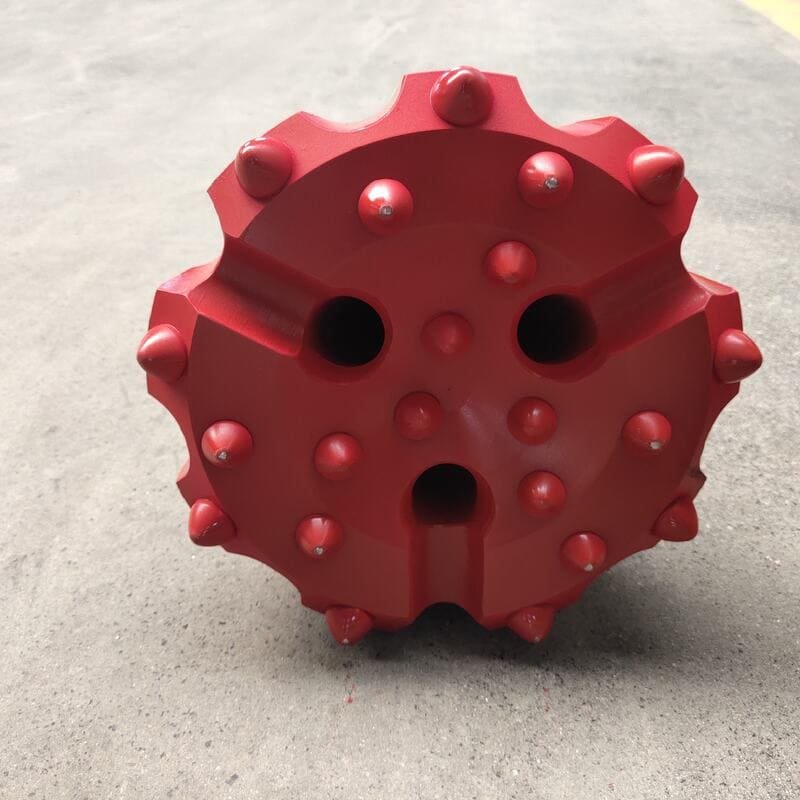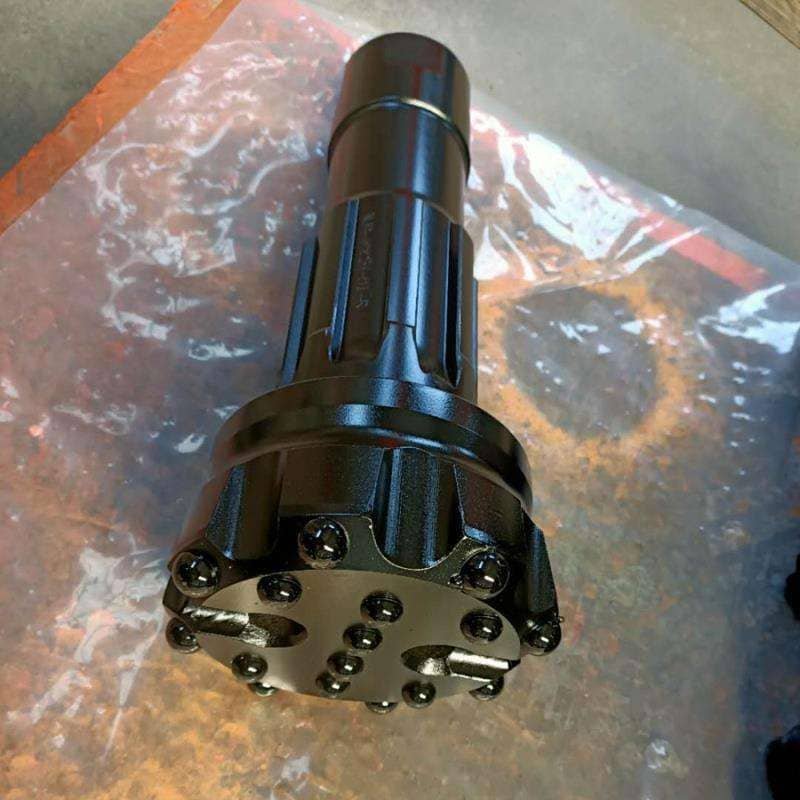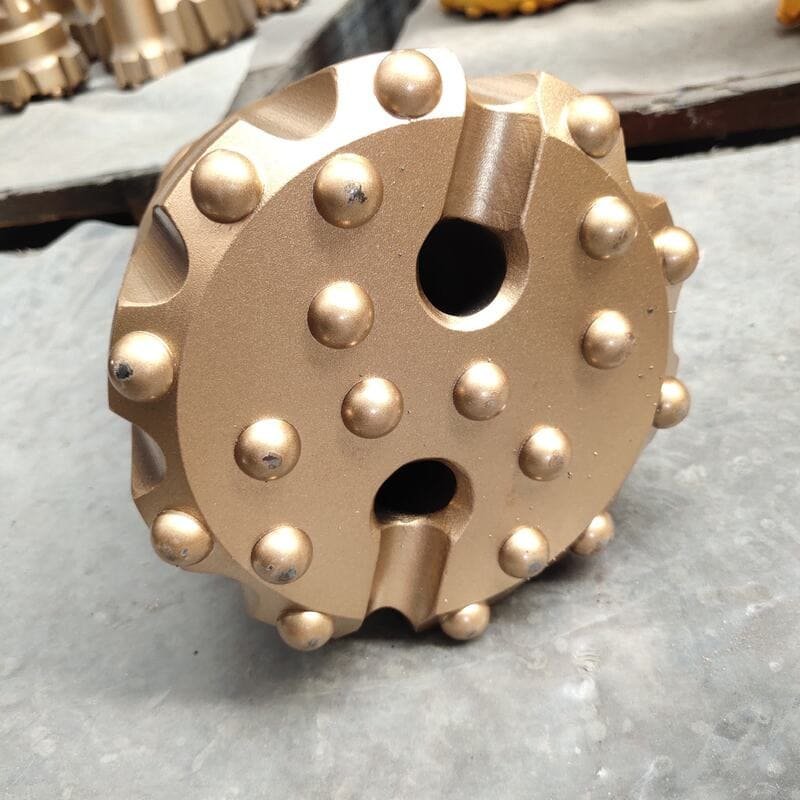Have you ever looked at a bunch of solid rocks and wondered which drill bit would break through them?
Flat face DTH drill bits work well in hard, rough rocks. They perform best where staying strong is more important than drilling quickly. These bits keep things steady and last a long time. This durability lowers the chance of a hole going off-target in challenging environments. They are very reliable.
I remember my first big drilling project - facing a huge granite wall. Regular bits did not work at all. That's when I found flat face DTH drill bits. These bits remind me of the tortoise in a race. They are not the quickest, but they go on and on and get things just right. They are perfect for days when you need everything to be exact, like when building a foundation or working with rock that can easily break and mess up your drill. They do not rush through tasks. Their toughness in tough conditions is really unmatched.
Flat face DTH drill bits excel in soft soil conditions.False
These bits are designed for hard and abrasive rock, not soft soil.
Flat face DTH bits offer high bit longevity.True
They are durable, providing robust performance in tough conditions.
Why Opt for Flat Face Bits in Hard Rock Drilling?
Have you ever had trouble drilling through tough, hard rock? Flat face bits might really be what you need.
Flat face drill bits are popular for drilling in hard rock. They spread impact evenly. This increases durability. Boreholes stay precise. Even in tough conditions, precision remains. Very effective tools for rock work.

Strong Design for Tough Rock Conditions
Picture a time when I had to drill through a hard granite slab. This rock seems to mock any effort to break it. Flat face bits are the heroes here. Their design spreads impact force evenly on the surface, helping parts wear out less and keeping drilling steady. It's necessary when facing the strongest nature offers.
| Benefits of Flat Face Bits |
|---|
| Even impact distribution |
| Enhanced durability |
| Consistent drilling rate |
In places like mining and construction, the quality of drilled holes can change project success. Flat face bits give operational stability1.
Staying on Track with Fractured Rock
In my experience, a drill bit going off course can ruin a project. Think about a task where every millimeter is important and there's fractured rock all around. Here, flat face bits truly shine. They stick to the path, providing precise drilling, crucial for geological work.
- Operational Benefits: Strong design keeps precision.
- Application Suitability: Perfect for projects needing vertical or angled drilling.
Discover more on how flat face bits offer precision control2 in hard drilling tasks.
When Bit Durability Is Key
I know that time equals money, especially in drilling. Changing bits too often wastes both. Flat face bits stand out here, lasting longer under tough conditions than other bits. This durability saves money and prevents job delays.
- Economic Benefits: Longer life means less downtime.
- Project Efficiency: Keeps performance consistent with fewer replacements.
Look into the economic advantages3 of using flat face bits in projects. Knowing these can guide smart choices for hard rock drilling gear.
Flat face bits reduce wear in hard rock drilling.True
The even distribution of impact force reduces wear on specific parts.
Flat face bits are unsuitable for fractured rock formations.False
They maintain alignment in fractured rocks, ensuring precision.
How Do Flat Face Bits Enhance Stability in Fractured Rocks?
I remember my first time dealing with broken rocks during drilling; it felt like threading a needle in strong wind. Flat face bits provide the needed stability. They help keep everything steady.
Flat face bits keep steady in cracked rocks. They stay aligned and stop the hole from going off course. Their strong structure spreads out impact forces evenly. This design is great for accurate and dependable drilling work.

Understanding Flat Face Bit Design
Flat face bits played a crucial role in drilling through broken rock. Their flat shape not only looks strong but also spreads impact forces evenly. This characteristic prevents any one part from wearing out quickly, ensuring a steady drilling progression. A smoother process is very important on unpredictable rock surfaces, as it directly affects the accuracy and effectiveness of the operation.
Operational Stability and Alignment
Keeping things stable is key, especially when rocks below might shift suddenly. I discovered that keeping the bit aligned with the borehole is vital. Flat face bits handle this challenge directly. They are made to keep aligned, reducing deviation. Precision becomes essential in projects like geotechnical drilling4 or construction.
Advantages in Fractured Rock Formations
Think of drilling into rocks as uncertain as a wobbling tower of blocks. Many bit designs struggle, but flat face bits remain steady. Their strong build withstands tough conditions, ensuring the borehole stays on track. This dependability is a huge benefit for projects demanding precise vertical or angled drilling paths.
| Feature | Benefit |
|---|---|
| Robust Design | Maintains alignment, reducing deviation |
| Even Force Distribution | Minimizes wear, ensuring longevity |
| Precision Drilling | Ideal for projects requiring accuracy |
Applications and Practical Insights
Flat face bits serve as a reliable partner, especially in projects needing stability and accuracy. Construction drilling5 or geotechnical tasks benefit from these bits. Their toughness contributes to cost savings in large operations where frequent replacement is unwelcome.
It's crucial to know the geological conditions before use. Prioritizing stability and durability over speed often proves that flat face bits suit difficult environments very well. By prioritizing stability and durability over speed, flat face bits prove to be an excellent choice for challenging environments6. Durability matters.
Flat face bits reduce hole deviation in fractured rocks.True
Flat face bits' robust design maintains alignment, reducing deviation.
Flat face bits wear out faster than other bit designs.False
Even force distribution minimizes wear, ensuring bit longevity.
Why Are Flat Face Drill Bits Perfect for Precision Drilling?
Imagine drilling with accuracy, like guiding a well-trained arrow to its mark - this is the wonder of flat face drill bits.
Flat face drill bits are excellent for precise drilling. They keep steady contact with rock surfaces, which reduces deviation and gives more control. Their solid design offers stability. These bits are ideal for hard and abrasive conditions. Yes, ideal.

Understanding the Design
When exploring different drill bits, the flat face bit caught my eye with its simplicity and effectiveness. It’s like a reliable friend always ready to help. The flat face has a wide contact area with the rock, which helps in distributing impact forces7 evenly. This is really similar to spreading weight when walking on thin ice.
Stability and Control
I once worked on a project where precision was critical. It felt like threading a needle on a rollercoaster. Flat face bits saved the day. Their stability kept the bit from bouncing off course, which is essential for projects needing high accuracy.
- Stability: Provides a steady path, reducing deviation.
- Control: Gives the operator better command in tricky conditions.
Application in Hard Rock Drilling
These bits are like off-road vehicles of the drilling world. Their strong design is ideal for hard rock environments. They can withstand pressure and resist premature wear, lasting longer than others—like tough boots on rugged hikes that never quit.
| Feature | Benefit |
|---|---|
| Large Contact Surface | Even force distribution |
| Minimal Deviation | Maintains drill path integrity |
| Enhanced Durability | Suitable for abrasive conditions |
Performance Under Abrasive Conditions
In situations where speed isn’t everything, endurance matters most. Here, flat face bits shine by reducing replacement frequency and saving money—like a winter coat that lasts for years.
Their wear resistance8 keeps them effective for longer periods, making them perfect for long projects where reliability is very important.
Practical Considerations for Use
Precision projects need precise tools. For vertical or angled drilling, flat face bits offer excellent control by keeping the drill straight as an arrow—a critical feature in construction or geological work where structural integrity is essential.
Choosing these bits requires considering environmental conditions and project needs—it’s like packing the right gear for a trip to ensure success.
Comparing Flat Face Bits with Other Designs
Flat face bits are a top choice for precision and durability as they balance strength and accuracy—hard to beat.
| Bit Design | Precision | Durability | Best Use Case |
|---|---|---|---|
| Flat Face | High | High | Hard rock, minimal deviation |
| Concave | Moderate | Moderate | Faster penetration needs |
| Convex | Low | Low | Softer rock, less precision |
Understanding flat face bits helps decide their use in projects. Consulting experts or reading detailed product specifications9 helps achieve the best performance tailored to specific needs.
Flat face bits provide even force distribution.True
Their large contact surface allows for uniform impact force distribution.
Flat face bits are unsuitable for hard rock drilling.False
They are ideal due to their durability and resistance to wear.
Are Flat Face Bits Cost-Effective for Long-Term Projects?
Picture yourself at a drilling site with tough rock and limited money. Flat face bits could save the day in projects that last a long time. Let's explore how these are good for saving costs.
Flat face bits perform well in long projects with tough, scratchy rocks. They last a long time and do not need frequent replacements, which reduces waiting periods. Smart decision-makers choose them for their long life and low cost.

Understanding Flat Face Bits
First time seeing flat face bits? Imagine battling stubborn rocks on a job site. These bits are like a skilled worker’s trusty tool, managing tough tasks without failing. Built to last, they provide a sturdy option when durability matters more than speed. They are popular for long projects.
Key Advantages
-
Durability in Tough Conditions
- Picture your favorite hiking boots that never let you down. The flat face design spreads impact force evenly, reducing wear. Fewer swaps mean more time working.
- Perfect for tackling abrasive rocks, they keep projects moving smoothly where bit longevity10 is critical.
-
Reduced Maintenance Costs
- Like a dependable car avoiding frequent garage trips, these bits save on maintenance costs and lessen downtime.
- In remote areas, where getting new parts feels like waiting forever, fewer replacements help a lot.
Comparing with Other Bit Designs
| Bit Type | Advantages | Disadvantages |
|---|---|---|
| Flat Face | Long-lasting, cost-effective in hard rock | Slower penetration rate |
| Concave Face | Faster drilling in soft formations | Higher wear rate, more replacements needed |
| Convex Face | Balanced penetration and durability | Less effective in very hard, abrasive conditions |
Flat face bits stand out when looking at different designs. Their design handles tough conditions better.
When to Choose Flat Face Bits?
- Project Longevity: Think of choosing a strong camping tent for a long stay outdoors. These bits are ideal for projects needing constant performance over time.
- Specific Conditions: When speed isn’t crucial but steady work matters, flat face bits suit your needs best where steady performance11 is needed.
Considerations for Procurement
- Cost vs. Benefit: Imagine comparing a high-quality winter coat to a budget one that might leave you cold halfway through the season. Weighing the upfront cost of these bits against potential savings in downtime and fewer replacements is very important.
- Environmental Fit: Like needing running shoes that match the ground, checking geological conditions makes sure these bits are fit for the task.
For someone like Gary, knowing these points helps in picking tools that match project needs and budgets. Smart choices in this area can lead to significant savings, especially in tough conditions. Their sturdy nature adds to project success while controlling costs.
Flat face bits are ideal for abrasive rock conditions.True
Their robust design ensures longevity, minimizing wear in tough conditions.
Flat face bits have the fastest penetration rate.False
They are durable but have a slower penetration rate compared to others.
How Do Flat Face Bits Compare to Other Bit Designs?
Curious about why flat face bits often top the list for drilling in difficult situations?
Flat face bits work very well for drilling hard, rough rocks, providing stability and long-lasting use. These bits do not drill too aggressively, so they probably keep holes very straight and last longer. Precision projects often require such tools. Precision projects indeed need such reliable tools.

Drilling Efficiency in Hard Rock Conditions
Flat face bits impress me when drilling through tough, abrasive rocks12. Their design is perfect for tough environments. Imagine drilling with a concave or convex bit and it starts wearing unevenly. Flat face bits share impact evenly, so they endure intense pressure. They are the dependable friend you really need.
| Bit Type | Best Use | Advantages |
|---|---|---|
| Flat Face | Hard, abrasive rocks | Even wear distribution, stability |
| Concave | Soft to medium rock | High penetration rate |
| Convex | Medium to hard rock | Versatility, moderate penetration |
Stability and Hole Deviation Control
Precision matters in my work. Flat face bits excel in this area. I use them to keep things steady, literally. In foundation drilling or geotechnical projects13, these bits help maintain the drill path with minimal deviation. It's comforting. They provide accuracy for project specifications.
Longevity and Cost-Effectiveness
I learned that durability matters a lot. Flat face bits offer time and money savings in projects where life span matters more than speed. Their design requires fewer replacements, probably saving on operational expenses14.
Comparing Penetration Rates
It's true. Flat face bits are not the fastest for penetration. Yet, their lifespan compensates for that. Pointed or concave bits work faster but wear quickly. Priorities differ, right?
- Flat Face: Slower penetration but longer life
- Pointed/Concave: Faster penetration but increased wear
Exploring specific geological settings helps in bit design comparisons15. This understanding assists in choosing the best bit type for individual needs.
Flat face bits wear evenly in hard rock conditions.True
Their design distributes impact evenly, maintaining integrity.
Concave bits are best for hard, abrasive rocks.False
Concave bits are suited for soft to medium rocks, not hard rocks.
Conclusion
Flat face DTH drill bits excel in hard, abrasive rock conditions, offering durability and precision for projects requiring stability over speed, minimizing hole deviation and maximizing cost-effectiveness.
-
Learn how flat face bits enhance operational stability, crucial for consistent performance in mining applications. ↩
-
Explore how flat face bits provide control, minimizing deviation in drilling paths. ↩
-
Understand the cost benefits and project efficiency gained from using durable flat face bits. ↩
-
Explore how flat face drill bits function in fractured rock environments, focusing on their design advantages. ↩
-
Learn about applications where precision drilling with flat face bits is essential, including case studies and industry examples. ↩
-
Understand the challenges faced when drilling in fractured rocks and how flat face bits mitigate these issues. ↩
-
Explore how impact forces are managed by flat face bits to improve drilling accuracy. ↩
-
Learn about the materials and design features that enhance wear resistance in flat face bits. ↩
-
Review detailed specifications to ensure the selected bit matches your project requirements. ↩
-
Discover why flat face bits are preferred for projects prioritizing bit longevity. ↩
-
Understand how steady performance in tough conditions benefits long-term projects. ↩
-
Discover why flat face bits are ideal for hard rock drilling, offering even wear and stability. ↩
-
Learn how flat face bits provide superior control for precision drilling applications. ↩
-
Explore how durable drill bits like flat face designs reduce operational costs. ↩
-
Compare different drill bit designs to find the best fit for your specific drilling conditions. ↩








